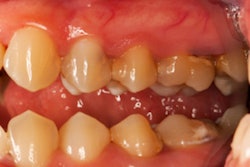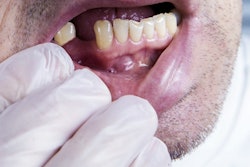
Increased alveolar bone loss due to periodontitis may be associated with a heightened risk of all-cause death, according to a large study that followed U.S. men for decades. The findings were published on September 12 in the Journal of Clinical Periodontology.
A 14% increase in the hazard of mortality was linked with each one-unit increase in the mean alveolar bone loss score, the authors wrote.
"Long-term evaluation of periodontal status in relation to all-cause mortality affirms existing evidence of a positive association, underscoring the importance of prevention and proper disease management and mitigation," wrote the authors, led by Brenda Heaton, PhD, MPH, of the Boston University Henry M. Goldman School of Dental Medicine in Boston.
To explore the correlation between periodontal disease and all-cause mortality, researchers conducted a study comprising 1,156 men who participated in the Veterans Affairs (VA) Dental Longitudinal Study, a long-term study with an average of 30 years of follow-ups across participants. In 1968, when the men enrolled in the VA study, they were between the ages of 25 and 85. They had repeated exams and dental x-rays were taken about every three years over the follow-up period through 2007.
Mean whole-mouth radiographic alveolar bone loss was scored using a five-point Schei ruler, with each unit representing 20% increments of alveolar bone loss to define periodontal status. Regression models were used to estimate hazard ratios for the association between continuous and categorical alveolar bone loss and death. All deaths were confirmed through the U.S. Social Security Administration, the U.S. Department of Veterans Affairs, next of kin, and postal authorities in instances of returned mail, according to the study.
In the model in which alveolar bone loss was included as a continuous variable, the results showed a 14% increase in the hazard of mortality for each one-unit increase in the mean alveolar bone loss score after adjusting for covariates, including body mass index, the authors wrote.
The study's results should be interpreted with some limitations, including generalizability, kept in mind. The participants were men living in the Boston metropolitan area who did not have any chronic conditions at baseline, and 97% identified as white, the authors wrote.
Nevertheless, the results further link periodontal disease to whole-body health. In the U.S., periodontitis affects more than 40% of adults. Worldwide, severe periodontitis affects an estimated 10% of the population.
Though gum disease has been linked with other noncommunicable chronic, systemic diseases and an increased risk of mortality from all causes in past studies, there was significant diversity in both the assessment and clinical definition of periodontitis across the literature. Unfortunately, this limited the value of the calculated effect estimates.
Furthermore, different ways of measuring gum disease may have varying etiological implications and, therefore, may result in different effect estimates when gauged against the same health outcomes. For instance, measuring bone loss, which may represent a cumulative inflammatory burden, may be linked with health outcomes differently than an assessment of current inflammation, which may indicate the current, but not necessarily the cumulative, inflammation load.
"A prolonged inflammatory burden, resulting in the loss of bone, as assessed radiographically, is associated with an increased hazard of all-cause mortality," Heaton et al concluded.




















